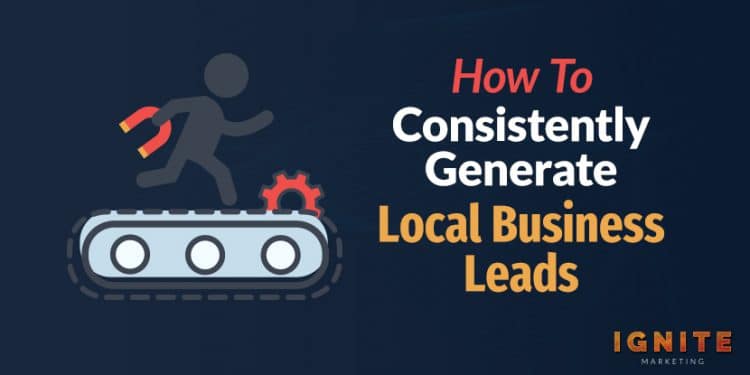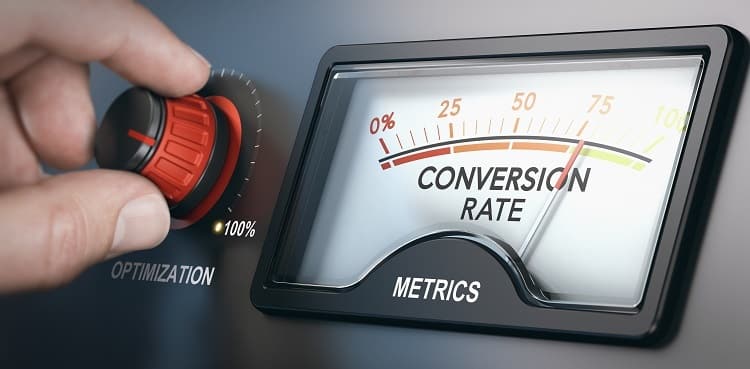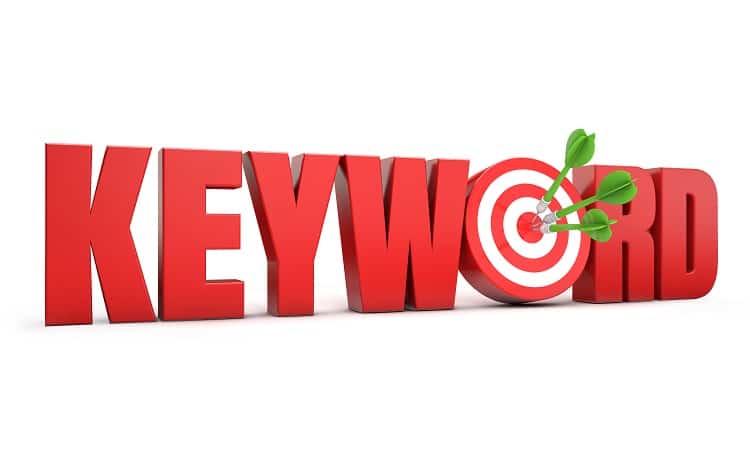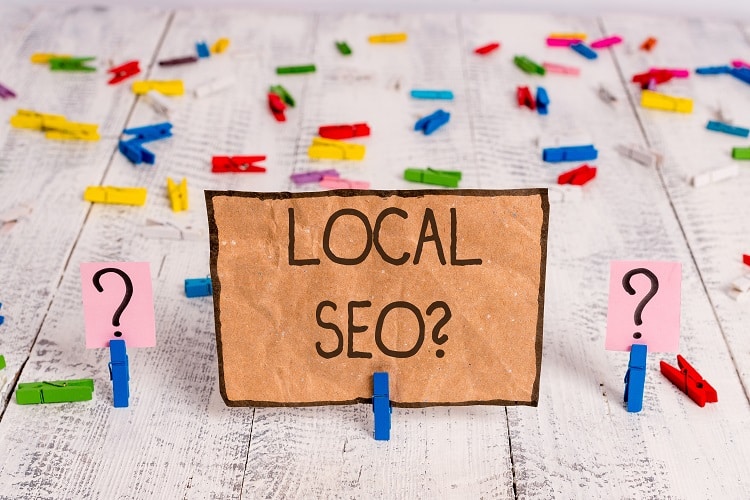


If you want to grow your local business, you need to develop ways to consistently bring in new customers.
In the old days, having a listing in the phone book and placing some ads in the newspaper was more than enough.
Things have changed, though.
To turn modern consumers into customers, you need to design a sales funnel that attracts potential buyers and gently pushes them to make a purchase.

If you want to nurture people interested in your business and increase the likelihood they become customers, you'll first need to get their contact information.
Once someone expresses an interest in your products or services and gives you their contact information, they become a lead.
Obtaining leads is an essential part of the customer acquisition process. And if you want your business to grow, you need to develop a strategy that consistently generates new leads.
This article will walk you through that strategy. We'll cover every single way a local business can generate leads and provide actionable advice for implementing each step.
So, if you'd like to jump start the growth of your local business by bringing in a ton of qualified leads, read on.
Before we get into the specifics, I'd like to provide an overview of the two main approaches to lead generation: inbound and outbound.
Inbound lead generation is a process where potential leads find your business, typically while they're searching for an answer to a problem. Here are some specific examples of inbound lead generation strategies:
There are many benefits to using inbound strategies for lead generation purposes.
First of all, it's incredibly cost-effective. Inbound lead generation relies on creating useful content and placing that content where interested consumers will find it. As long as you're able to create the content yourself, the cost per generated lead will be almost nothing.
It's also pretty low-risk. Because you're not spending buckets of money on ads, you can afford to experiment and mess up from time to time.
The majority of the strategies we'll discuss in this article will be inbound. However, you can still make money generating leads with outbound strategies, too.

Outbound lead generation involves using interruptive messages to place your business in front of unsuspecting consumers. Here are some examples of outbound lead generation strategy:
The main benefit of outbound lead generation is how quickly you can see an impact. With the right messaging and a substantial marketing budget, you can see near-instantaneous results.
We'll also cover some outbound strategies in this article. However, as many local businesses are risk-averse when it comes to marketing, I'll only be reviewing targeted methods that provide the highest number of leads for the lowest price.
Alright, it's time to get into the specifics. Before you start actively trying to generate leads, you need to understand who it is you're speaking to.
Understanding who your target market is and how to effectively reach them is a critical part of lead generation. You need to keep that information in mind as you build your lead generation machine.
The best way to develop an understanding of your target market is by creating a buyer persona.

A buyer persona is a fictional representation of your ideal customer. Making one will enable you to get inside the head of the people most likely to buy what you're selling, which will be invaluable as you create content and marketing materials.
There are many ways you can structure a buyer persona, though I recommend you at least include the following information:
If you have an existing customer base, you can obtain this information by asking customers to fill out a survey answering these questions. Offer a discount to entice them to complete the survey.
If you have a new business without an established customer base, you may have to do a bit of guesswork. That's okay ‒ once you do get some customers, you can fine-tune your persona using their survey responses.
Your website is the hub for all of your lead generation efforts.
To convert as many potential customers as possible, you need to do all you can to get people on your site, keep them on your site, and entice them to sign up for a lead magnet offer.

The homepage will be the first thing that many potential leads see. Make an excellent first impression by adding sharp, professional images wherever it seems appropriate.
The types of photos you add will depend on your business. Here are a few possibilities:
A website optimized for lead generation needs signup forms everywhere, including the homepage. To gather as many leads as possible, place your form front and center as soon as the homepage loads.
For many businesses, the homepage also doubles as a sales page. Provide essential details about your product or service by writing direct and compelling copy.
Here are a couple of tips for writing homepage copy that turns website visitors into leads.
Content pages are where you host blog posts, videos, infographics, or other forms of content. These are an important piece of the lead generation puzzle, as many of your leads will initially find you when they find your content on a search engine or social media platform.
If you want people to consume your content, you need to entice them to click on the content. And the best way to do that is to write a headline that attracts attention and accurately conveys what the content is offering.
To write headlines that improve clickthrough rates, use the following tips.

Adding a relevant, high-quality featured image to your article has three primary benefits:
Content created for promotional reasons should end with a concise CTA. If you don't add one, readers aren't going to take the action you want them to take.
Some business owners are willing to do whatever it takes to stand out.
While I'm all for taking risks to grow your business, I recommend playing it safe when it comes to font selection.
Choose a font that is aesthetically pleasing and easy to read. You should also use different fonts for headlines and body content, as it will help differentiate the two.
Depending on your lead generation strategy, you may or may not use a conversion-focused landing page for lead generation purposes.
If you're primarily focusing on inbound methods like content marketing, this section might not be relevant to you. But if you're using outbound strategies like PPC search ads or social media ads, you should give this section a thorough read.
Landing pages are typically associated with trying to sell a product or service.
But if your lead magnet is sophisticated and requires a bit of explanation, you might also find it beneficial to create a landing page with some persuasive copy for your lead magnet.

Once again, the "write a good headline" tip makes an appearance. I know it seems repetitive, but it's vitally important.
According to copywriting legend David Ogilvy, five times as many people read the headline as the body copy. If you want to pull people in and convince them to sign up for your lead magnet offer, your landing page headline needs to be stellar.
Anyway, here are a few types of headlines you can implement on your landing pages.
Diluting your message with multiple calls-to-action will confuse readers and hurt your conversion rates. Keep things linear and consistent with a single CTA.
If you have multiple lead magnet offers you want to advertise, place them on separate landing pages and target people separately.
Don't make a single landing page containing all of your offers. It'll create a paradox of choice problem and you'll get less leads than if you stuck with a single offer.
The phrasing you use for your landing page headline should be similar to the headlines you use in any ads you run promoting the landing page.
This isn't for stylistic purposes; an experiment run by Optimizely found that changing their landing page headline to match their ad headlines resulted in a 39% increase in conversions.
Now, you don't have to phrase each headline in the same way. Just be sure to use the same primary keywords in both headlines.
A quick run-through of the Optimizely experiment should give you a better idea of what I'm talking about.
Optimizely was trying to generate leads by offering free use of their split testing tool. They were running PPC search ads to target Google users, and then forwarding the people who clicked the ad to a landing page where they could sign up for the offer.
As it turns out, there are three different phrases people use to refer to split testing: split testing, A/B testing, and multivariate testing.
Initially, Optimizely was only customizing their ad headlines to the exact phrase users were searching for. So, if the user typed in "A/B testing tool" or "Multivariate testing tool," the ad headline would read "A/B testing tool" or "Multivariate testing tool" respectively.
However, the landing page headline they linked to was the same regardless of the user's search phrase: "Test It Out For Free."
Optimizely's conversion rates were decent with this approach, but they decided to experiment with symmetrical headlines.
In the new symmetrical format, the landing page headline included the same phrase as the ad headline. So, if the ad headline read "Split Testing Tool," the landing page headline would read "The #1 Split Testing Tool."
This slight change resulted in an almost 40% boost in conversions and serves as proof that you should use symmetry in your own lead generation efforts.
Deciding where to place your signup form can have a significant impact on the effectiveness of your landing page. The most critical choice you'll make regarding form placement is whether to place it "above the fold" or "below the fold."

Any elements you place above the fold will be visible to the user as soon as the webpage loads.
And anything you place below the fold won't be visible on the initial load, and the user will have to scroll down to view it.
If your lead magnet is on the complex side, you might be better off placing the lead capture form below the fold. This will allow you to add persuasive copy above it and better explain the value of your lead magnet to potential leads.
There's only one way to find out, though: split test your form placement.
Create separate landing pages, with the lead capture form in a different place on each page. Link to different pages from different ads or pieces of content and see which performs best.
An all-text landing page is a non-converting landing page. To attract the attention of readers and pull them into the offer, you need to stand out with some professional, compelling imagery and design.
If you have any photos that convey the value of your lead magnet well, feature them on the landing page. The right image presented in an appealing way can significantly boost lead generation conversion rates.
Here are a few design tips specific to landing pages for lead capture forms.
Many internet users don't read articles or landing pages all the way through. They scan through headlines and bullet points to see if any are relevant to their situation. If they find one that is, they may stop to read the surrounding text to check for additional pertinent information.
To accommodate these users and ensure they reach your lead capture form, make your text scannable by using plenty of bullet points, breaking paragraphs into small chunks, and keeping sentences as short and free of fluff as possible.
Once the user inputs their information and hits the submit button, you should redirect them to a Thank You page.

This page serves two purposes: it strengthens your relationship with your freshly generated lead, and it allows you to push other pieces of content that might move the lead further down the sales funnel.
You can also use the Thank You page to track conversions in your analytics software. You can tell Google Analytics to count every visit to this page as a conversion. Doing this will let you track the number of leads that come from each page on your website, allowing you to determine which strategies are working and which need to be changed.
Many businesses treat the About page as an opportunity to wax poetic about their many years of operation and how committed they are to customer satisfaction. You can do this, too, but it would be a waste of a valuable page that many potential leads may visit.
Instead of writing a bland overview of your company, use the About page as yet another source of leads. Write some persuasive copy that ends with a CTA for your lead magnet. You'll almost certainly get some new customers.
Here are a few copywriting tips specific to About pages.
You should talk about yourself on your About page. It's just important that whatever you say about yourself isn't dull.
Explain how your business came to fruition. Do it in a fun and exciting way, and readers will simultaneously develop a connection with your business and be drawn further down the page toward the lead capture CTA.
Make sure you keep it light and avoid praising yourself too much. The last thing you want your About page to do is portray you as conceited and full of yourself.
On top of providing some colorful background, you should also use the About page to explain what your company stands for. This can be as brief as a single sentence, but it's important that readers come away with a sense of your priorities and values.
Every good About page has a picture of some kind.
If you run a business where customers specifically want to see you (lawyer, doctor, etc.), then a professional headshot is a reliable option.
If your business offers a product or service that doesn't involve seeing a specific person (restaurant, factory, etc.), then a photo of your team would be more appropriate.
While headshots and group photos are two of the most common options, they aren't the only image types you can use. You can also add photos or images that show your most popular products or services in action.
It might seem odd to add a CTA to an About page, but it's necessary if you want to use the page to bring in leads. Add a compelling CTA that links to a lead magnet landing page. Or, better yet, place a lead capture form at the bottom of the About page itself.
If you're using inbound methods to fuel your lead generation efforts, many of your leads will come from search engines like Google.
To consistently bring in traffic from Google, you need to ensure your website and content is optimized for SEO. Doing this will help you rank above your competitors and send more potential leads to your site. For effective strategies, look here for link building techniques that can boost your rankings even further.

Also, I mention Google specifically because they have over 90% of global search engine market share. So, while each search engine has slightly different metrics for determining your rank, Google is the one you should be optimizing for.
When deciding how to rank pages, Google cares about one factor over all others: how well the page helps the user with their query.
As such, making fantastic content that helps people solve their problems will improve your ranks more than anything else.
It's important to note that making longer content doesn't necessarily mean that content is more helpful.
While a longer word count typically means the content goes into more detail than shorter content, filling the page with extra words for the sake of it will likely hurt your rankings and damage your lead generation efforts.
Site speed is one of the other major factors impacting Google's ranking algorithm. Optimize for fast page loading to improve your site speed and beat out the competition.

If you want to know how quickly your website is currently loading, you can use the Google PageSpeed Insights tool. It will score your speed for both mobile and desktop viewing, as well as give you page-specific tips for decreasing load speed.
More than half of all internet users browse the web with their mobile phones. To accommodate these users and increase your chances of converting them into leads, you need to optimize your website for mobile viewing.
While keyword matching has become less and less important with recent Google search algorithm updates, you should still use the keywords you're trying to target in prominent locations on your page.
Two of the most impactful locations include the page title and meta description. Add at least the key portions of your target keyword to improve your search rankings.
Web users have come to expect a certain type of formatting from the landing and content pages they visit. To meet user expectations and make your website as easy to use as possible, use the following tips to format content properly.
A broken link is a link that no longer works. Google sees broken links as an indication that your content isn't as helpful as it could be and may penalize you in the search rankings if you have any broken links lurking in your content.

If you use WordPress, the Broken Link Checker plugin makes it easy to find and replace links that were typed incorrectly or have stopped working.
Google doesn't like convoluted URLs that contain a bunch of unnecessary numbers or words. Keep your URLs simple and short by only adding essential keywords after your domain name.
Here are a few examples:
Linking to other pages on your site shows Google that your content is related to the other content on your site, which is something they take into account when ranking pages.
So, when you're writing a new blog post, link to other articles on your blog whenever it seems relevant. It will improve the user experience and generate more leads through a higher ranking in the search results.
Don't be greedy with links. If you know of a fantastic resource that your readers would find helpful, link to it!
Not only will this improve your authority and trust among your readers, it will also signal to Google that your content is accurate.
One of the best indicators that your content is helpful is when other websites link back to you. Backlinks show Google that other influencers in your industry value your advice so much that they're willing to direct readers to your website.
One of the most recent updates in SEO is the rise in the importance of E-A-T. If you're writing content that could have a significant impact on someone's life (health, finance, etc.), you need to prove that you know what you're talking about.
While this is annoying, it makes sense from Google's perspective. Their algorithm essentially decides what people believe is true. If they give an article that provides incorrect information the top spot in the search results, most people who find that article will end up believing something that isn't true.
Google's algorithm isn't intelligent enough to know what is right and what is wrong; they need to rely on the credibility of the author.
Here are a few ways you can build E-A-T and improve your search rankings.
An SSL certificate encrypts all data users send through your website, ensuring user data remains protected. Google wants every website on the planet to have an SSL certificate, so adding one may give you an edge on competing websites that lack this protection.
Adding an SSL certificate is easy and free. If you don't have one on your site, reach out to your web host and ask them to help you install it.
If you want to create a consistent lead generation machine for your local business, you need content to share with interested consumers. Blog posts, videos, and other forms of content will build inroads for potential leads to find you through.

And making content will not only bring you leads but will also establish you as a trusted authority in your industry.
As a local business, much of your content will be geared toward social media platforms. The easiest way to organically reach a target market in a specific location is by sharing that content on social media and hoping your local followers share the content with their networks.
Ranking your content in the search results is a useful strategy, but it's less effective than social media for local business lead generation. Unless you use location-targeted PPC search ads, most of the people who find your content through a search engine won't be located in your area.
How does content help with lead generation?
Simple: it brings people to your site so that they can have the option of filling out a lead capture form.
To learn how to make outstanding content that brings in leads and helps convert those leads into paying customers, use the following tips.
No matter which format you use to present your content, you need to make sure the information presented in the content is accurate. Few things are more damaging to your brand and credibility than presenting false information as truth.
To make an incorrect statement as unlikely as possible, stick to authoritative sources. If you want to be thorough, you can hunt down the original source for claims that other articles you're sourcing from make.
To engage and educate people with your content, you first need to get them to look at the content. If you write succinct, catchy headlines, you'll be able to entice people to click on your content and will have a direct impact on the number of leads you generate.
I mentioned this earlier in the SEO section, but it's so important that it's worth repeating. If you want to convince people to sign up for your lead magnet offers, you first need to show them that your opinion is worth having.
Making astoundingly helpful content will build trust between you and your visitors, making them more likely to hand over their contact information when you offer premium educational content in exchange for it.
Typos and grammatical errors make your content seem sloppy and unprofessional. To catch these errors before publishing, run your posts through a tool like Grammarly and weed out the imperfections.
One of the most useful forms of content at your business's disposal is the blog post. It requires almost no resources to create, is extremely shareable, and can be consumed by people using any device and working with every level of internet speed.
While the search engines won't be your primary target, it's still smart to optimize your content for them. Use keywords in your blog post titles and meta descriptions to improve your search rankings.

Many internet users don't have the patience for long-winded walls of text. Break your content down into short, easy-to-read paragraphs to improve the user experience and get more people to read your posts in their entirety.
If you have information that is best presented in a table format, don't settle for bullet points. If you have WordPress, you can use a plugin like TablePress to insert responsive, easy-to-read tables into your articles.
A good blog post is all about readability. Make it easy for visitors to scan through your content by using an abundance of relevant subheadings.
More than 50% of marketing professionals think video is the most effective way to reach consumers.
You don't need an expensive studio setup to create professional videos. If you have a smartphone, a cheap microphone, and some video editing software, you can create videos that bring potential leads to your website without breaking the bank.
Here are some essential tips for creating videos that your target market will find enjoyable.
No matter what kind of video you produce, you should host it on YouTube. It's the second-most visited website on the Internet, and leveraging its popularity gives you the best chance of reaching your target market.

Nobody likes a boring video. Even if the purpose of your video is purely informational, use your personality to lighten the mood and make the video somewhat entertaining.
Posting your video on YouTube isn't the only way to reach your target audience. You should also share it via Facebook, Twitter, Instagram, email, and any other platforms you use to communicate with consumers.
Blog posts and videos are the most common forms of content, but they're not the only types you can produce. Here's a list of other content formats you can use to generate leads.
A lead magnet is something of value you give interested consumers in exchange for their contact information. This typically takes one of three forms: a piece of educational content, a discount on your products or services, or a free trial or demo of your product.
Discounts and free trials are pretty self-explanatory. I will go into more detail on the most common types of educational content, though.

A webinar is a long-form video that thoroughly explains a topic, product, or service. If you have a video camera, a microphone, and some screen recording software, you can easily create a webinar about almost anything.
Creating an eBook is another popular lead magnet option. If you have some writing chops or some money to hire a ghostwriter, you can create a helpful eBook that people interested in your business will want to download.
According to Hubspot, a whitepaper is "a persuasive, authoritative, in-depth report on a specific topic that presents a problem and provides a solution."
If you sell a product or service that has a higher level of complexity, offering a whitepaper as a lead magnet can be a great way to both generate leads and position your product as a solution to the problems your leads are experiencing.
The way you design your signup form will have a huge impact on the number of leads you generate. Use the following tips to create the best signup form possible.
The fewer fields you have on a form, the more likely a potential lead will take the time to fill it out. If you need more information to feed your CRM, don’t try to get it on the initial signup form.
A study by ConversionXL found that single-column forms are completed more than 15 seconds faster than multi-column forms. Make your form as usable as possible by avoiding two-column layouts.
Separating your form from the rest of the page will help it stand out. One of the best ways to do this is to place it in a standalone container. Be sure to give the container a background color that differentiates it from the other elements on the page.
"Free" is one of the most powerful words in marketing. Telling users that your lead magnet is free will entice them to sign up and increase conversion rates.
While the purpose of your signup form is to collect information, you should also use it to communicate the value of your lead magnet offer. At the very least, include a headline that succinctly conveys the value potential leads will get from your offer.
Your CTA will make or break your form conversion rates. Keep the CTA short and harness the power of exciting action words to generate as many leads as possible.
We already discussed SEO optimization from a content perspective. But as a local business, it's also important you build your local SEO on both your website and other prominent local business platforms. For this, consulting with Sites n Leads SEO experts can significantly enhance your strategy and ensure you're maximizing your local visibility.

Most people who find your business through a search engine will be doing so through Google.
As such, it's vitally important that your business has a Google My Business listing. Creating one will allow Google to display important information about your business in a sidebar to the right of the normal search results.
It will also get your business into the Google Maps search results, which will bring additional traffic to both your website and physical location.
So if you don't have a Google My Business profile yet, go to Google.com/business and create one.
Google My Business isn't the only local business tool you should be using.
Yelp, the Yellow Pages, and other local directories can also bring in additional leads. Find these directories and add your NAP information to increase the visibility of your business.
Adding detailed contact information to your site will give you a rankings boost in the Google search results.
Social media provides one of the best lead generation opportunities available to local businesses. It gives you instant access to location-centric groups, making it relatively easy to build up a following of interested consumers who live close to your business.
While establishing a presence on every social platform seems like a good idea on the surface, you should only consider it if you can give each platform the attention it deserves.
As most local business owners don't have a dedicated marketing team, you probably won't be able to cover every platform your target market is using.
So instead of stretching yourself too thin, stick to the platforms your target market uses most. This will almost always include Facebook, though you may also want to build a presence on YouTube, Instagram, Twitter, and LinkedIn.
People aren't following your social pages to be spammed with promotions. Keep an 80/20 mix of helpful content to promotional content to keep followers happy and keep them from unfollowing your page.
As Facebook is the one platform every single local business should be using, I've included a few Facebook-specific lead generation tips.
The first step to building a presence on Facebook is to make a Facebook business page. Doing so has a few primary benefits:
Paying for a boost gets your post higher in the feeds of your followers, increasing the likelihood that they see and interact with it.
Boosting can also place your post in the feeds of people who don't follow you, making it an excellent way to gain new followers who may eventually turn into leads.
Facebook offers many ad formats that serve different purposes. One of these is the lead generation format, which allows you to turn Facebook users into leads by displaying a link to a lead capture form in their news feeds.
The main benefit of lead generation ads is that users don't have to leave the Facebook ecosystem to become leads.
Most lead generation efforts that involve social media force users to leave the platform and head to another website to complete the signup process.
While there's nothing inherently wrong with forcing users to go to your site, it may result in fewer leads overall.
As Facebook users want to stay on Facebook, you'll probably convert more with a lead generation ad than another type of ad that links to a landing page.
As we discussed in the previous section, running targeted ads can be a terrific way to bring in a lot of leads relatively quickly.

Here are a few of the most cost-effective ad types you can use for lead generation.
Buying targeted advertisements on the Google search results can help you leapfrog the organic competition and send potential leads to a relevant piece of content or landing page.
To generate the highest ROI and number of leads from your ad budget, use the following tips.
As a local business, you should show ads to people who live in the area surrounding your physical location.
Ad extensions are a great way to give your ad additional functionality. Some common extensions include a phone number, business address, and links to specific landing pages with lead capture forms.
To get the most out of your ads, you want to show them when your target market is most likely to click.
Determining the right time to show ads is difficult without data, so you should run them 24/7 at first to see which times bring in the most leads.
Facebook lead generation ads and PPC search ads are two of the most effective ad formats for lead generation.
They aren't the only options, though. The following ad formats can also be used to drive traffic to your website.
If you read through the entirety of this guide, you should be fully prepared to create a marketing machine that consistently generates new leads for your business.
There's one step I didn't mention, though: you need to take action.
You can read through a hundred guides on the internet, but you're not going to get a single new customer unless you implement the advice those guides give you.
So, get out there and take the next step toward implementing your lead generation plan. Soon enough, those small but meaningful actions will result in a flood of new customers walking through your door.
